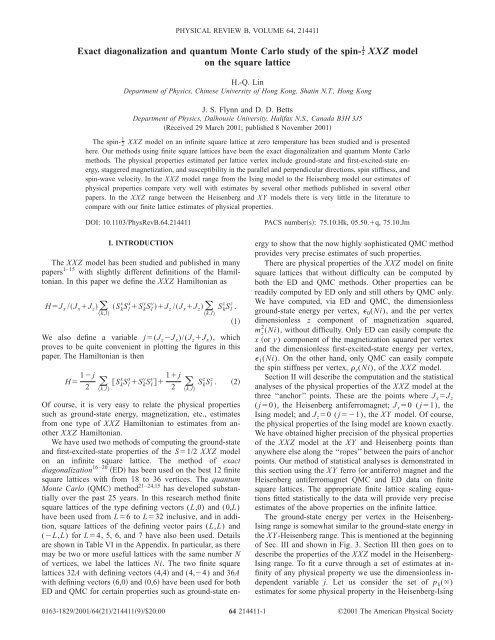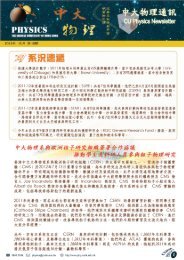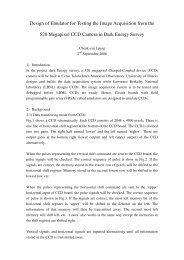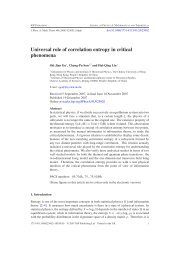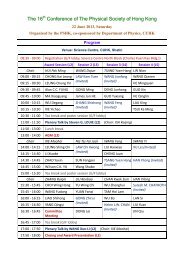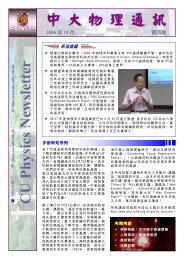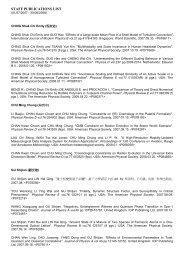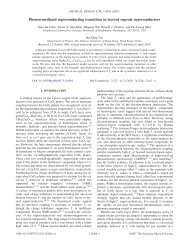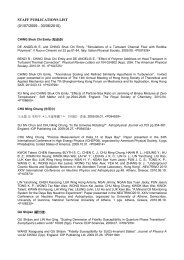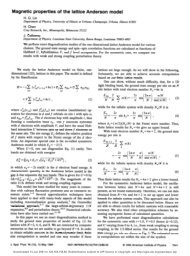Exact diagonalization and quantum Monte Carlo study of the spin-1 ...
Exact diagonalization and quantum Monte Carlo study of the spin-1 ...
Exact diagonalization and quantum Monte Carlo study of the spin-1 ...
- No tags were found...
You also want an ePaper? Increase the reach of your titles
YUMPU automatically turns print PDFs into web optimized ePapers that Google loves.
PHYSICAL REVIEW B, VOLUME 64, 214411<br />
<strong>Exact</strong> <strong>diagonalization</strong> <strong>and</strong> <strong>quantum</strong> <strong>Monte</strong> <strong>Carlo</strong> <strong>study</strong> <strong>of</strong> <strong>the</strong> <strong>spin</strong>- 1 2 XXZ model<br />
on <strong>the</strong> square lattice<br />
H.-Q. Lin<br />
Department <strong>of</strong> Physics, Chinese University <strong>of</strong> Hong Kong, Shatin N.T., Hong Kong<br />
J. S. Flynn <strong>and</strong> D. D. Betts<br />
Department <strong>of</strong> Physics, Dalhousie University, Halifax N.S., Canada B3H 3J5<br />
Received 29 March 2001; published 8 November 2001<br />
The <strong>spin</strong>- 1 2 XXZ model on an infinite square lattice at zero temperature has been studied <strong>and</strong> is presented<br />
here. Our methods using finite square lattices have been <strong>the</strong> exact <strong>diagonalization</strong> <strong>and</strong> <strong>quantum</strong> <strong>Monte</strong> <strong>Carlo</strong><br />
methods. The physical properties estimated per lattice vertex include ground-state <strong>and</strong> first-excited-state energy,<br />
staggered magnetization, <strong>and</strong> susceptibility in <strong>the</strong> parallel <strong>and</strong> perpendicular directions, <strong>spin</strong> stiffness, <strong>and</strong><br />
<strong>spin</strong>-wave velocity. In <strong>the</strong> XXZ model range from <strong>the</strong> Ising model to <strong>the</strong> Heisenberg model our estimates <strong>of</strong><br />
physical properties compare very well with estimates by several o<strong>the</strong>r methods published in several o<strong>the</strong>r<br />
papers. In <strong>the</strong> XXZ range between <strong>the</strong> Heisenberg <strong>and</strong> XY models <strong>the</strong>re is very little in <strong>the</strong> literature to<br />
compare with our finite lattice estimates <strong>of</strong> physical properties.<br />
DOI: 10.1103/PhysRevB.64.214411<br />
I. INTRODUCTION<br />
The XXZ model has been studied <strong>and</strong> published in many<br />
papers 1–15 with slightly different definitions <strong>of</strong> <strong>the</strong> Hamiltonian.<br />
In this paper we define <strong>the</strong> XXZ Hamiltonian as<br />
HJ x /J x J z <br />
k,l<br />
S k x S l x S k y S l y J z /J x J z <br />
k,l<br />
S k z S l z .<br />
We also define a variable j(J z J x )/(J z J x ), which<br />
proves to be quite convenient in plotting <strong>the</strong> figures in this<br />
paper. The Hamiltonian is <strong>the</strong>n<br />
1<br />
H 1 j<br />
2<br />
<br />
k,l<br />
S k x S l x S k y S l y 1 j<br />
2<br />
<br />
k,l<br />
S k z S l z . 2<br />
PACS numbers: 75.10.Hk, 05.50.q, 75.10.Jm<br />
Of course, it is very easy to relate <strong>the</strong> physical properties<br />
such as ground-state energy, magnetization, etc., estimates<br />
from one type <strong>of</strong> XXZ Hamiltonian to estimates from ano<strong>the</strong>r<br />
XXZ Hamiltonian.<br />
We have used two methods <strong>of</strong> computing <strong>the</strong> ground-state<br />
<strong>and</strong> first-excited-state properties <strong>of</strong> <strong>the</strong> S1/2 XXZ model<br />
on an infinite square lattice. The method <strong>of</strong> exact<br />
<strong>diagonalization</strong> 16–20 ED has been used on <strong>the</strong> best 12 finite<br />
square lattices with from 18 to 36 vertices. The <strong>quantum</strong><br />
<strong>Monte</strong> <strong>Carlo</strong> QMC method 21–24,15 has developed substantially<br />
over <strong>the</strong> past 25 years. In this research method finite<br />
square lattices <strong>of</strong> <strong>the</strong> type defining vectors (L,0) <strong>and</strong> (0,L)<br />
have been used from L6 toL32 inclusive, <strong>and</strong> in addition,<br />
square lattices <strong>of</strong> <strong>the</strong> defining vector pairs (L,L) <strong>and</strong><br />
(L,L) for L4, 5, 6, <strong>and</strong> 7 have also been used. Details<br />
are shown in Table VI in <strong>the</strong> Appendix. In particular, as <strong>the</strong>re<br />
may be two or more useful lattices with <strong>the</strong> same number N<br />
<strong>of</strong> vertices, we label <strong>the</strong> lattices Ni. The two finite square<br />
lattices 32A with defining vectors 4,4 <strong>and</strong> (4,4) <strong>and</strong> 36A<br />
with defining vectors 6,0 <strong>and</strong> 0,6 have been used for both<br />
ED <strong>and</strong> QMC for certain properties such as ground-state energy<br />
to show that <strong>the</strong> now highly sophisticated QMC method<br />
provides very precise estimates <strong>of</strong> such properties.<br />
There are physical properties <strong>of</strong> <strong>the</strong> XXZ model on finite<br />
square lattices that without difficulty can be computed by<br />
both <strong>the</strong> ED <strong>and</strong> QMC methods. O<strong>the</strong>r properties can be<br />
readily computed by ED only <strong>and</strong> still o<strong>the</strong>rs by QMC only.<br />
We have computed, via ED <strong>and</strong> QMC, <strong>the</strong> dimensionless<br />
ground-state energy per vertex, 0 (Ni), <strong>and</strong> <strong>the</strong> per vertex<br />
dimensionless z component <strong>of</strong> magnetization squared,<br />
m z 2 (Ni), without difficulty. Only ED can easily compute <strong>the</strong><br />
x or y) component <strong>of</strong> <strong>the</strong> magnetization squared per vertex<br />
<strong>and</strong> <strong>the</strong> dimensionless first-excited-state energy per vertex,<br />
1 (Ni). On <strong>the</strong> o<strong>the</strong>r h<strong>and</strong>, only QMC can easily compute<br />
<strong>the</strong> <strong>spin</strong> stiffness per vertex, s (Ni), <strong>of</strong> <strong>the</strong> XXZ model.<br />
Section II will describe <strong>the</strong> computation <strong>and</strong> <strong>the</strong> statistical<br />
analyses <strong>of</strong> <strong>the</strong> physical properties <strong>of</strong> <strong>the</strong> XXZ model at <strong>the</strong><br />
three ‘‘anchor’’ points. These are <strong>the</strong> points where J x J z<br />
( j0), <strong>the</strong> Heisenberg antiferromagnet; J x 0 (j1), <strong>the</strong><br />
Ising model; <strong>and</strong> J z 0(j1), <strong>the</strong> XY model. Of course,<br />
<strong>the</strong> physical properties <strong>of</strong> <strong>the</strong> Ising model are known exactly.<br />
We have obtained higher precision <strong>of</strong> <strong>the</strong> physical properties<br />
<strong>of</strong> <strong>the</strong> XXZ model at <strong>the</strong> XY <strong>and</strong> Heisenberg points than<br />
anywhere else along <strong>the</strong> ‘‘ropes’’ between <strong>the</strong> pairs <strong>of</strong> anchor<br />
points. Our method <strong>of</strong> statistical analyses is demonstrated in<br />
this section using <strong>the</strong> XY ferro or antiferro magnet <strong>and</strong> <strong>the</strong><br />
Heisenberg antiferromagnet QMC <strong>and</strong> ED data on finite<br />
square lattices. The appropriate finite lattice scaling equations<br />
fitted statistically to <strong>the</strong> data will provide very precise<br />
estimates <strong>of</strong> <strong>the</strong> above properties on <strong>the</strong> infinite lattice.<br />
The ground-state energy per vertex in <strong>the</strong> Heisenberg-<br />
Ising range is somewhat similar to <strong>the</strong> ground-state energy in<br />
<strong>the</strong> XY-Heisenberg range. This is mentioned at <strong>the</strong> beginning<br />
<strong>of</strong> Sec. III <strong>and</strong> shown in Fig. 3. Section III <strong>the</strong>n goes on to<br />
describe <strong>the</strong> properties <strong>of</strong> <strong>the</strong> XXZ model in <strong>the</strong> Heisenberg-<br />
Ising range. To fit a curve through a set <strong>of</strong> estimates at infinity<br />
<strong>of</strong> any physical property we use <strong>the</strong> dimensionless independent<br />
variable j. Let us consider <strong>the</strong> set <strong>of</strong> p k ()<br />
estimates for some physical property in <strong>the</strong> Heisenberg-Ising<br />
0163-1829/2001/6421/2144119/$20.00<br />
64 214411-1<br />
©2001 The American Physical Society
H.-Q. LIN, J. S. FLYNN, AND D. D. BETTS PHYSICAL REVIEW B 64 214411<br />
range. A simple function f ( j,) is statistically fitted to <strong>the</strong><br />
p k () set <strong>of</strong> points. The resulting curve <strong>and</strong> <strong>the</strong> points can<br />
be displayed in a figure. The properties studied include <strong>the</strong><br />
ground-state energy 0 , <strong>the</strong> staggered magnetization squared<br />
m z 2 , <strong>and</strong> <strong>the</strong> parallel susceptibility . Each <strong>of</strong> <strong>the</strong> properties<br />
close to <strong>the</strong> Heisenberg end is very difficult to settle. This is<br />
especially true <strong>of</strong> <strong>the</strong> inverse parallel susceptibility.<br />
Section IV compares our T0 infinite N estimates <strong>of</strong> energy<br />
<strong>and</strong> staggered magnetization based on finite QMC<br />
<strong>and</strong>/or ED data with estimates <strong>of</strong> <strong>the</strong> same properties obtained<br />
by o<strong>the</strong>r colleagues see Refs. 1–4 using methods<br />
such as <strong>spin</strong> wave, series expansion, CMX, t expansion, etc.<br />
In general, our T0 infinite N estimates <strong>of</strong> <strong>the</strong> various properties<br />
<strong>of</strong> <strong>the</strong> XXZ model at a number <strong>of</strong> points along <strong>the</strong><br />
Heisenberg-Ising range are closely comparable to most <strong>of</strong> <strong>the</strong><br />
o<strong>the</strong>r estimates. However, in most o<strong>the</strong>r estimates <strong>the</strong> finite N<br />
second term coefficient has not been calculated <strong>and</strong> thus our<br />
second term coefficients have no o<strong>the</strong>r estimates with which<br />
to compare.<br />
Section V will first display as an example <strong>the</strong> finite lattice<br />
data for <strong>the</strong> physical properties 0 ( j,Ni) <strong>and</strong> 1 ( j,Ni) for<br />
j1/2. Then analyses similar to that <strong>of</strong> Sec. III although<br />
with different results are performed. In <strong>the</strong> XY-Heisenberg<br />
range <strong>the</strong> physical properties which are finite include <strong>the</strong><br />
susceptibility <strong>and</strong> staggered magnetization squared m x 2 in<br />
<strong>the</strong> perpendicular <strong>spin</strong>-space direction, <strong>the</strong> <strong>spin</strong> stiffness s ,<br />
<strong>and</strong> <strong>the</strong> <strong>spin</strong>-wave velocity v. Each <strong>of</strong> <strong>the</strong>m is zero in <strong>the</strong><br />
Heisenberg-Ising range. In <strong>the</strong> XY-Heisenberg range it is<br />
also difficult to settle <strong>the</strong> properties near <strong>the</strong> Heisenberg end.<br />
Finally Sec. VI is summary, discussion, <strong>and</strong> outlook. All<br />
<strong>of</strong> our large amount <strong>of</strong> original data remains in our computer’s<br />
memory.<br />
II. SÄ1Õ2 ISING, HEISENBERG, AND XY MODELS,<br />
PROPERTIES AT TÄ0<br />
The Ising, Heisenberg <strong>and</strong> XY models are special cases <strong>of</strong><br />
<strong>the</strong> XXZ model. The physical properties <strong>of</strong> <strong>the</strong> <strong>spin</strong>- 1 2 Ising<br />
model at zero temperature can easily be calculated exactly.<br />
The physical properties <strong>of</strong> <strong>the</strong> S1/2 Heisenberg antiferromagnet<br />
<strong>and</strong> <strong>the</strong> XY ferromagnet or antiferromagnet on <strong>the</strong><br />
infinite square lattice at T0 have been much studied <strong>and</strong><br />
calculated by various methods by many physicists. Never<strong>the</strong>less,<br />
we too have studied <strong>the</strong>se models on <strong>the</strong> square lattice<br />
at T0 because <strong>the</strong>y are anchor points <strong>of</strong> <strong>the</strong> S1/2 XXZ<br />
model. We have used both <strong>the</strong> exact <strong>diagonalization</strong> <strong>and</strong><br />
<strong>quantum</strong> <strong>Monte</strong> <strong>Carlo</strong> methods to obtain some properties <strong>of</strong><br />
<strong>the</strong>se two models on 28 suitable finite bipartite square<br />
lattices. 20 These lattices are listed in Table VI in <strong>the</strong> Appendix.<br />
For some properties we have used only ED on those<br />
lattices <strong>of</strong> 18N36 vertices. For o<strong>the</strong>r properties we have<br />
used only QMC on lattices <strong>of</strong> N32.<br />
There is a finite lattice scaling equation for each physical<br />
property <strong>of</strong> <strong>the</strong>se models. N is <strong>the</strong> number <strong>of</strong> vertices <strong>of</strong> a<br />
finite lattice, <strong>and</strong> <strong>the</strong> independent variable in two dimensions<br />
is N 1/2 L 1 . The most extensive <strong>and</strong> fundamental paper<br />
on finite lattice scaling equations seems to be that by Hasenfratz<br />
<strong>and</strong> Niedermayer. 25 In particular, for <strong>the</strong> S1/2 Heisenberg<br />
antiferromagnet <strong>the</strong> ground-state dimensionless energy<br />
FIG. 1. Ground-state energy per vertex plotted against N 3/2 for<br />
<strong>the</strong> XY ferromagnet (’s <strong>and</strong> Heisenberg antiferromagnet (’s.<br />
per vertex, 0 (), is equal to <strong>the</strong> first-excited-state energy<br />
1 () <strong>and</strong> in general s (). Fur<strong>the</strong>rmore, <strong>the</strong> next term in<br />
<strong>the</strong> scaling equation, A HA 3,s , is also independent <strong>of</strong> s, <strong>the</strong> S z<br />
state <strong>of</strong> <strong>the</strong> Hamiltonian.<br />
Below are some specific scaling equations. For dimensionless<br />
ground-state energies per vertex for <strong>the</strong> S1/2<br />
Heisenberg antiferromagnet,<br />
HA 0 L HA A HA 3 L 3 A HA 4,0 L 4 •••<br />
<strong>and</strong> for <strong>the</strong> S1/2 XY model<br />
XY 0 L XY A XY 3 L 3 A XY 5,0 L 5 •••. 4<br />
The square <strong>of</strong> <strong>the</strong> staggered magnetization per vertex,<br />
m 2 x (L), has <strong>the</strong> same scaling equation for <strong>the</strong> XY model as<br />
for <strong>the</strong> Heisenberg model or all points in <strong>the</strong> XXZ model in<br />
between. Similarly m 2 z (L) has <strong>the</strong> same scaling equation in<br />
<strong>the</strong> Heisenberg-Ising range, namely,<br />
m L 2 m 2 B 1 L 1 B 2 L 2 OL 3 .<br />
The next step is to fit statistically <strong>the</strong> appropriate finite<br />
lattice scaling equation to <strong>the</strong> set <strong>of</strong> data under consideration.<br />
We use <strong>the</strong> statistical programming package S-PLUS from<br />
MathS<strong>of</strong>t Inc., Seattle, to do <strong>the</strong> fitting. We have used an<br />
iterative process by throwing out one finite lattice at a time<br />
until all outriders a minority are eliminated.<br />
Figure 1 displays as points <strong>the</strong> ground-state energy per<br />
vertex <strong>of</strong> <strong>the</strong> Heisenberg antiferromagnet, 0 HA (Ni), <strong>and</strong> <strong>of</strong><br />
<strong>the</strong> XY ferromagnet, 0 XY (Ni), computed on lattices <strong>of</strong> 18<br />
N1024 vertices. The horizontal variable is L 3 N 3/2 .<br />
Also in Fig. 1 are <strong>the</strong> two finite lattice scaling equations,<br />
respectively, as two curves fitted statistically to <strong>the</strong> two sets<br />
<strong>of</strong> 0 (Ni) data.<br />
3<br />
5<br />
214411-2
EXACT DIAGONALIZATION AND QUANTUM MONTE ... PHYSICAL REVIEW B 64 214411<br />
1 XY L 0 XY L XY L2 XY 1 L 4 D 6 L 6<br />
OL 7 .<br />
Using our ED data we find numerically that<br />
11<br />
<strong>and</strong><br />
HA L6.61L 4 9.3L 5 2.9L 6<br />
12<br />
XY L2.37L 4 0.872L 6 . 13<br />
This means that D 5 0 for <strong>the</strong> XY model.<br />
Next we consider <strong>the</strong> <strong>spin</strong> stiffnesses XY s <strong>and</strong> HA s based<br />
only on QMC data. The relevant finite lattice scaling equations<br />
for <strong>the</strong> <strong>spin</strong> stiffness for <strong>the</strong> HA Ref. 26 <strong>and</strong> XY Ref.<br />
27 models are<br />
FIG. 2. Ground-state magnetization per vertex plotted against<br />
N 1/2 for <strong>the</strong> XY ferromagnet (’s <strong>and</strong> Heisenberg antiferromagnet<br />
(’s.<br />
<strong>and</strong><br />
The fitted equations are numerically<br />
0 HA N0.334721.136L 3 0.82L 4<br />
0 XY N0.548820.839L 3 0.30L 5 .<br />
Similarly, Fig. 2 displays as points <strong>the</strong> ground-state magnetization<br />
squared (m HA x,0 ) 2 (m HA y,0 ) 2 (m HA z,0 ) 2 for <strong>the</strong><br />
Heisenberg antiferromagnet <strong>and</strong> (m XY x,0 ) 2 (m XY y,0 ) 2 for <strong>the</strong> XY<br />
model. Whereas <strong>the</strong> (m HA z0<br />
) 2 data are computed via ED <strong>and</strong><br />
QMC for <strong>the</strong> XY model, <strong>the</strong> (m XY x,0 ) 2 data are computed only<br />
via exact <strong>diagonalization</strong>, as can be seen in <strong>the</strong> two sets <strong>of</strong><br />
points in Fig. 2. Accordingly <strong>the</strong> statistically fitted scaling<br />
equation for <strong>the</strong> Heisenberg antiferromagnet,<br />
m HA z,0 L 2 0.031070.2009L 1 0.196L 2 0.007L 3 ,<br />
8<br />
is more precise than that for <strong>the</strong> XY model:<br />
m XY x,0 L 2 0.09580.116L 1 0.12L 2 .<br />
The energies <strong>of</strong> <strong>the</strong> first excited state, HA 1 () <strong>and</strong><br />
XY 1 (), are not by <strong>the</strong>mselves <strong>of</strong> much interest. This is so<br />
especially since <strong>the</strong> data leading up to <strong>the</strong>se estimates are<br />
available now only for N36 as <strong>the</strong> QMC method has not<br />
been used because <strong>of</strong> serious difficulties. However, according<br />
to Hasenfratz <strong>and</strong> Neidermayer, 25 1 () 0 () <strong>and</strong><br />
also A 3,1 A 3,0 .<br />
Then <strong>the</strong> susceptibilities HA <strong>and</strong> XY are obtained 25 from<br />
<strong>the</strong> equations<br />
<strong>and</strong><br />
1 HA L 0 HA L HA L HA 1 L 4 D 5 L 5<br />
D 6 L 6 OL 7 <br />
6<br />
7<br />
9<br />
10<br />
<strong>and</strong><br />
is<br />
s HA L s HA c 1 L 1 c 3 L 3<br />
s XY L s XY c 3 L 3 .<br />
14<br />
15<br />
The numerical result for <strong>the</strong> Heisenberg antiferromagnet<br />
s HA L0.08990.015L 1 0.69L 3 .<br />
16<br />
The raw finite lattice data used in <strong>the</strong> original finite lattice<br />
scaling equation would result in statistical coefficients that<br />
would be two-thirds <strong>of</strong> <strong>the</strong> value <strong>of</strong> <strong>the</strong> coefficients above<br />
because <strong>of</strong> <strong>the</strong> method <strong>of</strong> obtaining <strong>the</strong> data. However, this is<br />
not <strong>the</strong> case for <strong>the</strong> XY magnet:<br />
s XY L0.26950.49L 3 .<br />
17<br />
It is well known that <strong>the</strong> <strong>spin</strong>-wave velocity v is related to<br />
s <strong>and</strong> via s v 2 . Thus we find v from <strong>the</strong> s <strong>and</strong> <br />
data. There is also ano<strong>the</strong>r way <strong>of</strong> determining <strong>the</strong> <strong>spin</strong>-wave<br />
velocity. Using <strong>the</strong> second coefficient in <strong>the</strong> finite lattice<br />
scaling equation for <strong>the</strong> ground-state or first-excited-state<br />
energy, we obtain ano<strong>the</strong>r estimate: vA 3 , in which <strong>the</strong><br />
geometric square lattice factor 1.437 745.<br />
All <strong>the</strong>se estimates are displayed in Table I. In that table<br />
both <strong>the</strong> Heisenberg <strong>and</strong> <strong>the</strong> XY model data we estimated are<br />
compared to relatively recent estimates by S<strong>and</strong>vik 28 <strong>and</strong><br />
S<strong>and</strong>vik <strong>and</strong> Hamer. 27 Our estimates <strong>of</strong> energy <strong>and</strong> staggered<br />
magnetization agree very closely with those in <strong>the</strong> recently<br />
published papers. On <strong>the</strong> o<strong>the</strong>r h<strong>and</strong>, susceptibility <strong>and</strong> <strong>spin</strong><br />
stiffness estimates are not very close to <strong>the</strong> estimates in <strong>the</strong><br />
above-mentioned publication.<br />
Our estimates over a range <strong>of</strong> j based on QMC <strong>and</strong> ED<br />
data will be compared with o<strong>the</strong>r j range estimates based on<br />
o<strong>the</strong>r methods in Sec. IV.<br />
III. ESTIMATED PROPERTIES OF THE XXZ MODEL IN<br />
THE RANGE 0ËjÏ1<br />
The physical properties <strong>of</strong> <strong>the</strong> S1/2 XXZ model on <strong>the</strong><br />
infinite square lattice are quite different in <strong>the</strong> two ranges <strong>of</strong><br />
j on ei<strong>the</strong>r side <strong>of</strong> <strong>the</strong> antiferromagnetic Heisenberg point, j<br />
0. That is why this paper has two different sections dis-<br />
214411-3
H.-Q. LIN, J. S. FLYNN, AND D. D. BETTS PHYSICAL REVIEW B 64 214411<br />
TABLE I. A comparison <strong>of</strong> physical properties <strong>of</strong> <strong>the</strong> XXZ model on <strong>the</strong> square lattice at particular,<br />
special points, or anchors. Statistical error <strong>of</strong> estimation is in paren<strong>the</strong>ses.<br />
Physical<br />
property<br />
Ising<br />
model<br />
Heisenberg antiferromagnet<br />
XY model<br />
Current S<strong>and</strong>vik 1997 Current SH 1999<br />
1 0 1/2 0.33472(3) 0.33472(1) 0.54882(3) 0.548824(2)<br />
2<br />
m z 1/4 0.03111 0.031426 0 0<br />
2<br />
m x 0 0.03111 0.031426 0.09582 0.0961<br />
0.1513 0.1252 0.2111 0.20962<br />
s 0 0.0901 0.0881 0.26952 0.26962<br />
v( s /) 1/2 0 0.773 0.822 1.132 1.1342<br />
vA 3 / 0 0.824 0.842 1.204 1.1232<br />
playing <strong>the</strong> estimates <strong>of</strong> <strong>the</strong> properties <strong>of</strong> <strong>the</strong> model. The<br />
ground-state or first-excited-state energy per vertex, ( j,),<br />
is more nearly symmetric about <strong>the</strong> J z J x or j0) point<br />
than any o<strong>the</strong>r property we have studied. Therefore we display<br />
( j,) in Fig. 3 over <strong>the</strong> entire range from <strong>the</strong> XY<br />
model through <strong>the</strong> Heisenberg point to <strong>the</strong> Ising model. In<br />
<strong>the</strong> range 0 j1, we have used energy scaling law 4. The<br />
( j,) data on <strong>the</strong> Ising side ( j0) are shown in Table II.<br />
They too are fitted well by <strong>the</strong> polynomial<br />
j,0.334720.01217j0.34252j 2<br />
0.24204j 3 0.07704j 4 .<br />
18<br />
The ( j,) data on <strong>the</strong> XY side <strong>of</strong> <strong>the</strong> Heisenberg ( j0)<br />
point, shown in Table V, have also been fitted well by <strong>the</strong><br />
polynomial<br />
j,0.334720.18205j0.03292j 2 .<br />
19<br />
The lack <strong>of</strong> symmetry is obvious. Notice that <strong>the</strong> sum <strong>of</strong> <strong>the</strong><br />
five coefficients in Eq. 19, (1,), is 0.500 07, extremely<br />
close to <strong>the</strong> exact Ising ground-state energy (1,)<br />
1/2.<br />
Throughout this range <strong>the</strong> staggered magnetization<br />
squared m x 2 ( j,)0 <strong>and</strong> <strong>the</strong> <strong>spin</strong> stiffness s ( j,)0, although<br />
this is not easy to determine explicitly where 0 j<br />
1. However, m z 2 ( j,)0 <strong>and</strong> so in Fig. 4 we show a set <strong>of</strong><br />
statistically estimated points, m z, j ()m j (), <strong>the</strong> staggered<br />
magnetization. Fur<strong>the</strong>rmore, a curve fitted statistically,<br />
m( j,), using all <strong>the</strong> points except those two points for j<br />
close to zero, is also in Fig. 4. The simple polynomial equation<br />
fitted to <strong>the</strong> points is<br />
m j,0.305300.40617j 1/2 0.20935j0.00280j 3/2 .<br />
20<br />
Next we consider , <strong>the</strong> susceptibility parallel to <strong>the</strong> <strong>spin</strong><br />
space z direction, by examining <strong>the</strong> scaling equation<br />
1 j,Ni 0 j,Ni j,Ni 1 <br />
L 4 D 5 jL 5<br />
D 6 jL 6 OL 7 .<br />
21<br />
TABLE II. Infinite N estimates <strong>of</strong> several physical properties <strong>of</strong><br />
<strong>the</strong> XXZ model in <strong>the</strong> range <strong>of</strong> j from <strong>the</strong> Ising model ( j1)<br />
toward <strong>the</strong> Heisenberg antiferromagnet ( j→0). The Heisenberg<br />
data in <strong>the</strong> last line is obtained directly from Table I.<br />
j 0 () 1 () A 3,0 A 3,1 m z 2 () B 1 1 ()<br />
FIG. 3. The points <strong>of</strong> 0 () have been estimated statistically<br />
from <strong>the</strong> precise XXZ data <strong>of</strong> <strong>the</strong> finite square lattices. The curves<br />
<strong>of</strong> ( j,) <strong>and</strong> ( j,) are derived from polynomials in j.<br />
1 0.5 0 0.25 0 0<br />
9/10 0.4754 0.000 0.2497 0.000 0<br />
4/5 0.4519 0.000 0.2486 0.000 0<br />
5/7 0.4325 0.000 0.2467 0.002 0<br />
3/5 0.4083 0.000 0.2427 0.004 0<br />
1/2 0.3889 0.001 0.2375 0.001 0<br />
7/17 0.3733 0.005 0.2298 0.010 0<br />
1/3 0.3610 0.017 0.2206 0.042 0<br />
3/11 0.3526 0.041 0.2120 0.028 0<br />
1/5 0.3444 0.003 0.1981 0.017 ?<br />
3/23 0.3384 0.009 0.1794 0.023 ?<br />
1/9 0.3371 0.031 NA NA ?<br />
1/11 0.3360 0.047 0.1641 0.059 ?<br />
1/17 NA NA 0.1489 0.092 ?<br />
0 0.33472 1.136 0.03107 0.201 0.151<br />
214411-4
EXACT DIAGONALIZATION AND QUANTUM MONTE ... PHYSICAL REVIEW B 64 214411<br />
FIG. 4. Precisely estimated points m j () in <strong>the</strong> Heisenberg-<br />
Ising range <strong>and</strong> a curve m( j,) fitted statistically using all points<br />
labeled with ’s.<br />
For any j1/2 we see very quickly that ( j,Ni)0 except<br />
for <strong>the</strong> smallest lattices. This can be seen in Fig. 5. In<br />
<strong>the</strong> intermediate-j region, ( j,Ni)0 only for <strong>the</strong> larger<br />
lattices. Then at <strong>the</strong> short range near to <strong>the</strong> Heisenberg point<br />
we find that ( j,Ni) remains finite even for <strong>the</strong> largest lattice<br />
available, Ni36A. These three sets <strong>of</strong> points are also in<br />
Fig. 5. It is clear that <strong>the</strong> parallel susceptibility is infinite for<br />
1/3 j1. Hence <strong>the</strong> <strong>spin</strong>-wave velocity v0.<br />
We can not discover whe<strong>the</strong>r in <strong>the</strong> range 0 j<br />
1/3. To do so we should have <strong>the</strong> ( j,Ni) for very large<br />
finite square lattices—far beyond <strong>the</strong> exact <strong>diagonalization</strong><br />
<strong>and</strong> even beyond <strong>the</strong> <strong>quantum</strong> <strong>Monte</strong> <strong>Carlo</strong> methods in use<br />
now <strong>and</strong> in <strong>the</strong> near future. Likely throughout <strong>the</strong><br />
whole range 0 j1.<br />
IV. COMPARISON OF PHYSICAL PROPERTIES OF THE<br />
XXZ MODEL AT TÄ0 ESTIMATED BY VARIOUS<br />
METHODS<br />
Many published articles have contained estimates <strong>of</strong> several<br />
physical properties <strong>of</strong> <strong>the</strong> XXZ model on <strong>the</strong> Ising side<br />
FIG. 5. (N) 0 (N) 1 (N) for <strong>the</strong> points j1/5 (’s, 1/2<br />
(’s, <strong>and</strong> 4/5 o’s. (N) is calculated from our finite lattice<br />
ground- <strong>and</strong> excited-state energy data.<br />
at T0 using a variety <strong>of</strong> means to do so. The recent paper<br />
by Witte et al. 1 estimated properties <strong>of</strong> <strong>the</strong> XXZ model in <strong>the</strong><br />
Heisenberg-Ising range using a plaquette expansion. The<br />
properties calculated by <strong>the</strong>m are <strong>the</strong> ground-state energy,<br />
<strong>the</strong> staggered magnetization in <strong>the</strong> z direction in <strong>spin</strong> space,<br />
<strong>and</strong> <strong>the</strong> excited-state gap. For each <strong>of</strong> <strong>the</strong>se properties <strong>the</strong>ir<br />
article displays a table comparing <strong>the</strong>ir estimates with estimates<br />
in o<strong>the</strong>r papers using five o<strong>the</strong>r methods.<br />
In Table III our finite lattice estimates <strong>of</strong> <strong>the</strong> ground-state<br />
energy in <strong>the</strong> range 0 j2/3 are compared with four sets <strong>of</strong><br />
o<strong>the</strong>r estimates displayed in Ref. 1. Three <strong>of</strong> <strong>the</strong>se sets were<br />
first published in Refs. 2–4. Note that we use Hamiltonian<br />
2 while a slightly different Hamiltonian has been used in all<br />
<strong>the</strong> papers referred to in this paragraph. To compare our<br />
0 ( j,), based on <strong>the</strong> Hamiltonian 2, with that in <strong>the</strong> paper<br />
by Witte et al., 1 based on <strong>the</strong>ir Hamiltonian 22, we first had<br />
to use Eq. 18 to reach <strong>the</strong> same x points. Second, we had to<br />
multiply simply our data by 2/(1 j) to compare ours with<br />
<strong>the</strong> data <strong>of</strong> o<strong>the</strong>rs.<br />
Our estimate at each <strong>of</strong> <strong>the</strong> j points agrees with <strong>the</strong> aver-<br />
TABLE III. Comparison <strong>of</strong> our estimates <strong>of</strong> <strong>the</strong> XXZ-model ground-state energy 0 ( j,) from Eq. 18<br />
with published estimates by o<strong>the</strong>r methods in <strong>the</strong> range 0 j2/3. All o<strong>the</strong>r estimates can be obtained from<br />
Table IV <strong>of</strong> <strong>the</strong> paper by Witte et al. Ref. 1 or directly from <strong>the</strong> papers referred to <strong>the</strong>rein.<br />
x j Finite Plaquette t expansion Third order Series<br />
J x /J z lattice expansion a Laplace b <strong>spin</strong> wave c expansion d Average<br />
0.2 2/3 0.5068 0.5067 0.5067 0.5066 0.5067 0.5067<br />
0.5 1/3 0.5411 0.5416 0.5416 0.5414 0.5417 0.5415<br />
0.8 1/9 0.6071 0.6069 0.6068 0.6074 0.6069 0.6070<br />
0.9 1/19 0.6365 0.6360 0.6354 0.6367 0.6358 0.6361<br />
0.98 1/99 0.6626 0.6622 0.6609 0.6629 0.6621 0.6621<br />
1.0 0 0.6694 0.6691 0.6677 0.6700 0.6693 0.6691<br />
a Reference 1.<br />
b Reference 2.<br />
c Reference 4.<br />
d Reference 3.<br />
214411-5
H.-Q. LIN, J. S. FLYNN, AND D. D. BETTS PHYSICAL REVIEW B 64 214411<br />
TABLE IV. Comparison <strong>of</strong> our estimates <strong>of</strong> <strong>the</strong> XXZ model staggered magnetization m( j,) with published<br />
estimates by o<strong>the</strong>r methods in <strong>the</strong> range 0 j2/3.<br />
Finite Plaquette t expansion Third order Series<br />
x j lattice expansion a D Padé b CMX b <strong>spin</strong> wave c expansion d<br />
0.2 2/3 0.4958 0.4955 0.4955 0.4955 0.4957 0.4955<br />
0.5 1/3 0.4695 0.4709 0.4710 0.4710 0.4717 0.4709<br />
0.8 1/9 0.4173 0.4162 0.4173 0.4173 0.4164 0.4169<br />
0.9 1/19 0.3865 0.383 0.386 0.3907 0.3839 0.3855<br />
0.95 1/39 0.3650 0.365 0.36 0.3752 0.3607 0.3627<br />
0.98 1/99 0.3440 0.357 0.35 0.3652 0.3406 0.3422<br />
0.99 1/199 0.3330 0.355 0.34 0.3617 0.3307 0.3319<br />
1.00 0 0.3053 0.353 0.33 0.3582 0.3069 0.307<br />
a Reference 1.<br />
b Reference 2.<br />
c Reference 4.<br />
d Reference 3.<br />
age <strong>of</strong> <strong>the</strong> five estimates within a few parts in 10 000. An<br />
important difference between our estimates <strong>and</strong> <strong>the</strong> o<strong>the</strong>r<br />
four estimates is that <strong>the</strong> o<strong>the</strong>r four methods start from <strong>the</strong><br />
exact Ising model or x0 <strong>and</strong> thus have <strong>the</strong> least precision<br />
<strong>of</strong> energy or o<strong>the</strong>r properties at x1. In contrast our estimates<br />
for each <strong>of</strong> several j’s or x’s start at <strong>the</strong> particular j<br />
with ED <strong>and</strong> QMC on finite lattices from N18 to very large<br />
vertices. Thence we obtain precise estimates <strong>of</strong> <strong>the</strong> energy<br />
or whatever as N→ for any value <strong>of</strong> j. In particular, for<br />
j0 or x1), <strong>the</strong> Heisenberg model, we have used energy<br />
data from 28 finite lattices <strong>of</strong> 18N1024 vertices. We<br />
claim that our estimate 0 (0,)0.66944. As a result <strong>the</strong><br />
differences between our estimate at x1 <strong>and</strong> <strong>the</strong>irs are as<br />
follows: plaquette, 0.0003; t expansion, 0.0017; <strong>spin</strong> wave,<br />
0.0006; <strong>and</strong> series, 0.0001. A similar set <strong>of</strong> differences can<br />
be seen at x0.99 with <strong>the</strong> t expansion estimate again <strong>the</strong><br />
far<strong>the</strong>st from <strong>the</strong> exact <strong>diagonalization</strong> estimate.<br />
Next we compare our staggered magnetization m with <strong>the</strong><br />
estimates from five o<strong>the</strong>r methods as displayed in Table V <strong>of</strong><br />
Ref. 1. Our estimates are easily derived from Eq. 20.<br />
Notice that throughout <strong>the</strong> range 0.2x0.9 all six sets<br />
<strong>of</strong> estimates are quite close to one ano<strong>the</strong>r. The estimates<br />
would be even closer to each o<strong>the</strong>r in <strong>the</strong> range 0.2x0,<br />
<strong>the</strong> Ising limit where m()1/2 exactly. In <strong>the</strong> range 0.90<br />
x0.99 <strong>the</strong> estimates using plaquette expansion <strong>and</strong> t expansion<br />
D Padé have larger confidence limits. Our finite lattice<br />
estimates in this range remain closest to <strong>the</strong> series expansion<br />
estimates <strong>and</strong> fairly close to <strong>the</strong> third-order <strong>spin</strong><br />
wave estimates. Our estimates <strong>of</strong> <strong>the</strong> staggered magnetization<br />
in Table IV are obtained from m( j,) in Eq. 20.<br />
In Table VI <strong>of</strong> Ref. 1 comparisons are made <strong>of</strong> five sets <strong>of</strong><br />
estimates derived from five methods for <strong>the</strong> ‘‘excited-state<br />
gap G’’ in <strong>the</strong> same range as above. The different estimates<br />
<strong>of</strong> G for <strong>the</strong> same j diverge greatly as j tends toward j0,<br />
<strong>the</strong> Heisenberg antiferromagnet. For example, for j1/99<br />
(x0.98) <strong>the</strong> estimates <strong>of</strong> G are 0.44, 0.45, 0.52, 0.27, <strong>and</strong><br />
0.26. We decided not to bo<strong>the</strong>r calculating G in our finite<br />
lattice estimate program.<br />
V. ESTIMATES OF XXZ MODEL PROPERTIES IN THE<br />
RANGE À1ÏjÏ0<br />
Next in Fig. 6 as an example are <strong>the</strong> ground-state <strong>and</strong><br />
first-excited-state ED energy data on all useful finite lattices<br />
<strong>of</strong> 18N36 vertices in <strong>the</strong> middle <strong>of</strong> <strong>the</strong> XY-Heisenberg<br />
range with j0.5 or J z /J x 1/3. At j1/2 <strong>and</strong> throughout<br />
<strong>the</strong> range 1 j0 we have used energy scaling law Eq.<br />
3 ra<strong>the</strong>r than Eq. 4. Clearly 1 ( j,) 0 ( j,). Fur<strong>the</strong>rmore,<br />
as N 3/2 or L 3 ) reaches zero <strong>the</strong> two slopes are very<br />
close to equal, A 3,1 (1/2)A 3,0 (1/2).<br />
At this point we introduce <strong>the</strong> statistical estimates <strong>of</strong> several<br />
properties <strong>of</strong> <strong>the</strong> S1/2 XXZ model on <strong>the</strong> infinite<br />
square lattice. The range is from <strong>the</strong> XY model to <strong>the</strong><br />
Heisenberg antiferromagnet, i.e., 1 j0. Nonzero properties<br />
in this range that can be calculated include <strong>the</strong> groundstate<br />
<strong>and</strong> first-excited-state energies per vertex, 0 () <strong>and</strong><br />
1 (), <strong>the</strong> coefficients <strong>of</strong> <strong>the</strong> second term in <strong>the</strong> energy scal-<br />
FIG. 6. The exact <strong>diagonalization</strong> energies 0 ( j,Ni) for <strong>the</strong><br />
ground state <strong>of</strong> <strong>the</strong> XXZ model at j1/2 are shown as ’s <strong>and</strong><br />
<strong>the</strong> 1 ( j,Ni) energies are shown as ’s. The curves are determined<br />
statistically using <strong>the</strong> finite lattice scaling equation 3.<br />
214411-6
EXACT DIAGONALIZATION AND QUANTUM MONTE ... PHYSICAL REVIEW B 64 214411<br />
TABLE V. Infinite N estimates <strong>of</strong> several physical properties <strong>of</strong><br />
<strong>the</strong> XXZ model in <strong>the</strong> range <strong>of</strong> j from <strong>the</strong> XY model ( j1) to <strong>the</strong><br />
Heisenberg antiferromagnet ( j0).<br />
j 0 () 1 () A 3,0 A 3,1 m x 2 () B 1 s () ()<br />
1 0.54882 0.84 0.095 0.12 0.2695 0.211<br />
9/11 0.50619 0.093 0.12 0.2435 0.207<br />
3/5 0.45714 0.77 0.089 0.13 0.2128 0.203<br />
1/2 0.43445 0.086 0.13 NA 0.200<br />
1/3 0.39888 0.67 0.080 0.14 0.1709 0.195<br />
1/4 0.38099 0.076 0.15 NA 0.191<br />
1/7 0.36010 0.56 0.072 0.14 0.1375 0.181<br />
1/15 0.34586 0.60 0.078 0.00 0.1204 0.152<br />
1/31 0.33985 0.75 0.079 0.10 0.1108 0.124<br />
1/63 0.33725 0.27 NA NA 0.1020 NA<br />
0 0.33472 1.14 0.034 0.18 0.0898 0.151<br />
ing equation, A 3,0 <strong>and</strong> A 3,1 , <strong>the</strong> ground-state staggered magnetization<br />
squared in <strong>the</strong> x direction, m x 2 (), <strong>and</strong> <strong>the</strong> coefficient<br />
B 1,0 <strong>of</strong> <strong>the</strong> second term in <strong>the</strong> magnetization scaling<br />
equation, <strong>the</strong> <strong>spin</strong> stiffness s , <strong>the</strong> perpendicular susceptibility<br />
, <strong>and</strong> <strong>the</strong> <strong>spin</strong>-wave velocity v. As <strong>the</strong> estimated magnetization<br />
on <strong>the</strong> infinite lattice in <strong>the</strong> x direction in <strong>spin</strong><br />
space has been obtained only from exact <strong>diagonalization</strong><br />
data, while <strong>the</strong> estimated <strong>spin</strong> stiffness has been obtained<br />
only from <strong>the</strong> <strong>quantum</strong> <strong>Monte</strong> <strong>Carlo</strong> data, not all <strong>the</strong> points<br />
in <strong>the</strong> j range are used for both m x 2 () <strong>and</strong> s (). These data<br />
are shown in Table V.<br />
The exact <strong>diagonalization</strong> data used to estimate m x 2 ()<br />
are on <strong>the</strong> 12 best lattices for which 18N36. We have<br />
estimated m x 2 ( j,) statistically using each set <strong>of</strong> exact <strong>diagonalization</strong><br />
data on finite N for each <strong>of</strong> ten j’s. These points<br />
are displayed in Fig. 7. Notice that <strong>the</strong> two points closest to<br />
<strong>the</strong> Heisenberg j0 point do not follow <strong>the</strong> trend <strong>of</strong> <strong>the</strong><br />
o<strong>the</strong>rs. We feel that <strong>the</strong> scaling, which is based on <strong>the</strong><br />
m x 2 ( j,Ni) exact <strong>diagonalization</strong> data, is more complex in <strong>the</strong><br />
FIG. 8. Nine estimated <strong>spin</strong> stiffness points s, j () in <strong>the</strong> XY-<br />
Heisenberg range are shown by ’s, <strong>and</strong> a curve <strong>of</strong> s ( j,) is fitted<br />
statistically using all points including <strong>the</strong> j0 Heisenberg point.<br />
range 0.1 j0 than in <strong>the</strong> range 1.0 j0.1. Accordingly<br />
we do not include <strong>the</strong> m x 2 (1/7,) <strong>and</strong> m x<br />
2<br />
(1/15,) data in fitting <strong>the</strong> coefficients in Eq. 20. Accordingly,<br />
we have not calculated exact <strong>diagonalization</strong> data<br />
for m x 2 (1/63,Ni). This change can also be seen in Table V<br />
under A 3,0 , m x 2 (), <strong>and</strong> B 1 in <strong>the</strong> 0.1 j0 range. To<br />
produce <strong>the</strong> curve in Fig. 7 <strong>the</strong> following equation is based<br />
on <strong>the</strong> seven remaining points:<br />
m x 2 j,0.0500.062 j 1/2 0.017 j.<br />
22<br />
The <strong>spin</strong> stiffness points s ( j,) over <strong>the</strong> same range <strong>of</strong> j<br />
have also been estimated statistically but from <strong>the</strong> <strong>quantum</strong><br />
<strong>Monte</strong> <strong>Carlo</strong> finite lattice data only. These s ( j,) points are<br />
shown in Fig. 8. The fitted curve here is determined by <strong>the</strong><br />
following equation:<br />
s j,0.09040.0905 j 1/2 0.0878 j.<br />
23<br />
The next property examined in <strong>the</strong> XY-Heisenberg range<br />
is <strong>the</strong> perpendicular susceptibility . We have <strong>the</strong> necessary<br />
data <strong>of</strong> 0 ( j,Ni) <strong>and</strong> 1 ( j,Ni), <strong>and</strong> we use <strong>the</strong>m in Eq.<br />
11 for all sets <strong>of</strong> 1 j0. The ( j,) is in Table V.<br />
Figure 9 displays <strong>the</strong>se points <strong>and</strong> <strong>the</strong> curve determined by<br />
<strong>the</strong> statistical equation<br />
j,0.14850.1045 j 1/2 0.0430 j. 24<br />
Finally we display <strong>the</strong> <strong>spin</strong>-wave velocity v in Fig. 10. It<br />
is well known that v( s / ) 1/2 , <strong>and</strong> we have s ( j,) <strong>and</strong><br />
( j,). Therefore <strong>the</strong> <strong>spin</strong>-wave velocity as a function<br />
v( j,) is simply obtained by dividing Eq. 23 by Eq. 24<br />
<strong>and</strong> <strong>the</strong>n taking <strong>the</strong> square root <strong>of</strong> <strong>the</strong> quotient.<br />
VI. SUMMARY, DISCUSSION, AND OUTLOOK<br />
FIG. 7. Ten precisely estimated magnetization points m 2 x, j () in<br />
<strong>the</strong> XY-Heisenberg range 1 j0 are shown by ’s, <strong>and</strong> a curve<br />
<strong>of</strong> m 2 x ( j,) is fitted statistically using all points with j1/15.<br />
We have studied <strong>the</strong> <strong>spin</strong>- 1 2 XXZ model on <strong>the</strong> infinite<br />
square lattice at zero temperature. To obtain precise data for<br />
our <strong>study</strong> we have used on finite square lattices <strong>the</strong> exact<br />
<strong>diagonalization</strong> <strong>and</strong> <strong>quantum</strong> <strong>Monte</strong> <strong>Carlo</strong> methods. We used<br />
214411-7
H.-Q. LIN, J. S. FLYNN, AND D. D. BETTS PHYSICAL REVIEW B 64 214411<br />
FIG. 9. Estimated susceptibility points , j () <strong>and</strong> a curve <strong>of</strong><br />
( j,) fitted statistically using all points except 1/15 j<br />
1/31 in <strong>the</strong> XY-Heisenberg range.<br />
32 finite lattices with 18–1000 vertices. The J z /J x ratios <strong>of</strong><br />
<strong>the</strong> Ising to XY terms we used in <strong>the</strong> XXZ Hamiltonian were<br />
38. Our data include properties <strong>of</strong> ground-state <strong>and</strong> firstexcited-state<br />
energy, staggered magnetization squared in<br />
<strong>the</strong> two different <strong>spin</strong>-space directions, (m z 2 ) <strong>and</strong> (m x 2 ), susceptibilities<br />
<strong>and</strong> , <strong>and</strong> finally we calculated data for <strong>the</strong><br />
<strong>spin</strong> stiffness s . Unfortunately we were unable to obtain m x<br />
2<br />
data from <strong>the</strong> <strong>quantum</strong> <strong>Monte</strong> <strong>Carlo</strong> method or to obtain<br />
<strong>spin</strong>-stiffness data from <strong>the</strong> exact <strong>diagonalization</strong> method.<br />
Any reader will underst<strong>and</strong> that <strong>the</strong> amount <strong>of</strong> finite N data<br />
we have computed is far too large to include in <strong>the</strong> Appendix;<br />
<strong>the</strong>y would require a book.<br />
For each physical property <strong>and</strong> each j for which we have<br />
data, we have fitted statistically <strong>the</strong> appropriate scaling equation<br />
for that property <strong>and</strong> range <strong>of</strong> j. Even <strong>the</strong> complete sets<br />
<strong>of</strong> coefficients <strong>of</strong> all <strong>the</strong> scaling equations are too large to<br />
display in one or more appendixes. However, in <strong>the</strong> special<br />
cases <strong>of</strong> <strong>the</strong> Heisenberg model, <strong>the</strong> XY model, <strong>and</strong> a few<br />
o<strong>the</strong>r values <strong>of</strong> j we have displayed a few properties in <strong>the</strong><br />
text <strong>and</strong> figures.<br />
We believe that we have obtained for <strong>the</strong> infinite square<br />
lattice at zero temperature an almost complete set <strong>of</strong> estimates<br />
<strong>of</strong> physical properties in one or more <strong>of</strong> three different<br />
places: <strong>the</strong> range from <strong>the</strong> Ising model to near <strong>the</strong> Heisenberg<br />
antiferromagnet, <strong>the</strong> range from <strong>the</strong> XY model to near<br />
<strong>the</strong> Heisenberg antiferromagnet, <strong>and</strong> <strong>the</strong> Heisenberg point<br />
between <strong>the</strong> two ranges. In <strong>the</strong> Heisenberg-Ising range, <strong>the</strong><br />
range much studied in <strong>the</strong> past, we have presented in Tables<br />
III <strong>and</strong> IV our estimates at infinity <strong>and</strong> those <strong>of</strong> four or five<br />
o<strong>the</strong>r estimates by o<strong>the</strong>r methods which are compared with<br />
ours. We have found that our estimates <strong>of</strong> <strong>the</strong> energy <strong>and</strong><br />
staggered magnetization in this range are as good as <strong>the</strong> best<br />
<strong>of</strong> <strong>the</strong>se properties obtained by o<strong>the</strong>rs.<br />
Our methods using finite lattices—namely, <strong>the</strong> <strong>quantum</strong><br />
<strong>Monte</strong> <strong>Carlo</strong> <strong>and</strong> exact <strong>diagonalization</strong> methods—are fundamentally<br />
different from familiar methods such as series expansion,<br />
<strong>spin</strong> wave, plaquette expansion, etc. Each <strong>of</strong> those<br />
methods in use for <strong>the</strong> XXZ model start from <strong>the</strong> exact Ising<br />
model data at T0 <strong>and</strong> reach as close as possible to <strong>the</strong><br />
FIG. 10. The <strong>spin</strong>-wave velocity points v()<br />
s () 1 () 1/2 in <strong>the</strong> 1 j0 range. The plotted line is<br />
v( j,).<br />
Heisenberg model with continuously lessening precision, as<br />
can be seen in <strong>the</strong> tables in Ref. 1 <strong>and</strong> elsewhere. Our finite<br />
lattice methods do equally well as a function <strong>of</strong> J x /J z in <strong>the</strong><br />
Ising-Heisenberg range except in <strong>the</strong> area close to <strong>the</strong><br />
Heisenberg model where J x J z .<br />
The most important feature <strong>of</strong> our finite lattice methods is<br />
<strong>the</strong> ability to <strong>study</strong> several properties <strong>of</strong> <strong>the</strong> XXZ model in<br />
<strong>the</strong> range from <strong>the</strong> XY model to close to <strong>the</strong> Heisenberg<br />
model. In our Sec. V we have displayed in equations <strong>and</strong> in<br />
Figs. 6–10 such properties as <strong>the</strong> zero-temperature energy,<br />
perpendicular staggered magnetization <strong>and</strong> susceptibility,<br />
<strong>spin</strong> stiffness, <strong>and</strong> <strong>spin</strong>-wave velocity. We have not found<br />
estimates by o<strong>the</strong>r methods in <strong>the</strong> XY-Heisenberg range that<br />
we can compare with ours.<br />
In <strong>the</strong> future we would like to find a way for <strong>spin</strong>-stiffness<br />
data to be obtained by exact <strong>diagonalization</strong> on finite lattices<br />
<strong>and</strong> for perpendicular magnetization data to be obtained by<br />
<strong>the</strong> <strong>quantum</strong> <strong>Monte</strong> <strong>Carlo</strong> method on finite lattices. We<br />
would like to have a better underst<strong>and</strong>ing <strong>of</strong> <strong>the</strong> properties <strong>of</strong><br />
<strong>the</strong> XXZ model at zero temperature very close on each side<br />
<strong>of</strong> <strong>the</strong> Heisenberg antiferromagnet by obtaining additional<br />
<strong>quantum</strong> <strong>Monte</strong> <strong>Carlo</strong> data on several square lattices considerably<br />
larger than our present 3232 square lattice. Later it<br />
would also be nice to <strong>study</strong> <strong>the</strong> XXZ model at finite temperature<br />
<strong>and</strong> at nonzero magnetic field.<br />
ACKNOWLEDGMENTS<br />
We are very pleased by <strong>the</strong> large amount <strong>of</strong> <strong>quantum</strong><br />
<strong>Monte</strong> <strong>Carlo</strong> data on <strong>the</strong> XXZ model computed by A. W.<br />
S<strong>and</strong>vik <strong>and</strong> given to us. These data were for <strong>the</strong> ground<br />
state <strong>and</strong> first excited state <strong>of</strong> <strong>the</strong> energy, <strong>the</strong> staggered parallel<br />
magnetization, <strong>and</strong> <strong>the</strong> <strong>spin</strong> stiffness on finite square<br />
lattices from N36 to N1024 for several ratios <strong>of</strong> J z /J x .<br />
He also discussed with us various points in our paper. We<br />
appreciate his help sincerely. We are also pleased at <strong>the</strong> help<br />
we received from C. J. Hamer in relation to chiral <strong>quantum</strong><br />
field <strong>the</strong>ory <strong>and</strong> W. Blanchard regarding statistical analyses.<br />
214411-8
EXACT DIAGONALIZATION AND QUANTUM MONTE ... PHYSICAL REVIEW B 64 214411<br />
M. Rovers was also very helpful in <strong>the</strong> initial data analysis<br />
stage. This research has been supported by <strong>the</strong> Research<br />
Grants Council <strong>of</strong> Hong Kong, <strong>the</strong> Natural Science <strong>and</strong> Engineering<br />
Research Council <strong>of</strong> Canada, <strong>and</strong> <strong>the</strong> Imperial Oil<br />
Charitable Foundation.<br />
TABLE VI. Bipartite finite square lattices used for exact <strong>diagonalization</strong><br />
<strong>and</strong>/or <strong>quantum</strong> <strong>Monte</strong> <strong>Carlo</strong> computation <strong>of</strong> <strong>the</strong> properties<br />
<strong>of</strong> <strong>the</strong> XXZ model. Each finite bipartite lattice is labeled by its<br />
number <strong>of</strong> vertices, N, <strong>and</strong> its place i in <strong>the</strong> set <strong>of</strong> those lattices <strong>of</strong> N<br />
vertices. A pair <strong>of</strong> vectors L 1 <strong>and</strong> L 2 define <strong>the</strong> lattices.<br />
Ni L 1 L 2 Ni L 1 L 2<br />
APPENDIX<br />
In recent papers, 19,20 including this paper, using <strong>the</strong><br />
method <strong>of</strong> exact <strong>diagonalization</strong> on bipartite finite square<br />
lattices, we examined <strong>the</strong> quality <strong>of</strong> <strong>the</strong> individual finite lattices.<br />
First, we believe that <strong>the</strong> best bipartite finite square<br />
lattices must have at least eighteen vertices. Second, we have<br />
determined that only <strong>the</strong> better <strong>of</strong> <strong>the</strong> bipartite finite square<br />
lattices <strong>of</strong> 18–36 vertices should be shown in Table VI below<br />
so that o<strong>the</strong>r scientists can use <strong>the</strong>m. An example <strong>of</strong> a<br />
poor lattice, 24B, sometimes used by o<strong>the</strong>rs, is defined by<br />
L 1 6,0 <strong>and</strong> L 2 0,4. Finally, in Table VI <strong>the</strong> lattices in<br />
<strong>the</strong> range 50A–1024A are found to be very good. However,<br />
we have not attempted to find more very good lattices within<br />
<strong>the</strong> latter range.<br />
18A 3,3 (3,3) 72A 6,6 (6,6)<br />
20A 4,2 (2,4) 98A 7,7 (7,7)<br />
22A 2,4 (5,1) 100A 10,0 0,10<br />
24A 4,4 (4,2) 144A 12,0 0,12<br />
24D 1,5 5,1 196A 14,0 0,14<br />
26B 1,5 (5,1) 256A 16,0 0,16<br />
28B 5,3 (1,5) 324A 18,0 0,18<br />
30A 5,3 (5,3) 400A 20,0 0,20<br />
32A 4,4 (4,4) 484A 22,0 0,22<br />
32B 2,6 (4,4) 576A 24,0 0,24<br />
34A 3,5 (5,3) 676A 26,0 0,26<br />
36A 6,0 0,6 784A 28,0 0,28<br />
50A 5,5 (5,5) 900A 30,0 0,30<br />
64A 8,0 0,8 1024A 32,0 0,32<br />
1 N.S. Witte, L.C.L. Hollenberg, <strong>and</strong> W.H. Zheng, Phys. Rev. B 55,<br />
10 412 1997.<br />
2 Zheng Weihong, J. Oitmaa, <strong>and</strong> C.J. Hamer, Phys. Rev. B 52, 10<br />
278 1995.<br />
3 Zheng Weihong, J. Oitmaa, <strong>and</strong> C.J. Hamer, Phys. Rev. B 43,<br />
8321 1991.<br />
4 C.J. Hamer, Zheng Weighong, <strong>and</strong> P. Arndt, Phys. Rev. B 46,<br />
6276 1992.<br />
5 T. Barnes, D. Kotchan, <strong>and</strong> E.S. Swanson, Phys. Rev. B 39, 4357<br />
1989.<br />
6 R.R.P. Singh <strong>and</strong> M.P. Gelf<strong>and</strong>, Phys. Rev. B 52, 15 695 1995.<br />
7 K. Kubo <strong>and</strong> T. Kishi, Phys. Rev. Lett. 61, 2585 1988.<br />
8 Y. Okabe <strong>and</strong> M. Kikuchi, J. Phys. Soc. Jpn. 57, 4351 1988.<br />
9 C.J. DeLeone <strong>and</strong> G.T. Zimanyi, Phys. Rev. B 49, 1131 1994.<br />
10 R. Bishop, R. Hale, <strong>and</strong> Y. Xian, Phys. Rev. Lett. 73, 3157<br />
1994.<br />
11 A. Cuccoli, V. Tognetti, <strong>and</strong> R. Vaia, Phys. Rev. B 52, 10 221<br />
1995.<br />
12 R.F. Bishop, D.J.J. Farnell, <strong>and</strong> J.B. Parkinson, J. Phys.: Condens.<br />
Matter 8, 11 153 1996.<br />
13 Y. Fukumoto, J. Phys. Soc. Jpn. 65, 569 1996.<br />
14 M. Kohno <strong>and</strong> M. Takahahi, Phys. Rev. B 56, 3212 1997.<br />
15 A.W. S<strong>and</strong>vik, Phys. Rev. B 59, R14 157 1999.<br />
16 J. Oitmaa <strong>and</strong> D.D. Betts, Can. J. Phys. 56, 897 1978.<br />
17 H.-Q. Lin, Phys. Rev. B 42, 6561 1990.<br />
18 O. Haan, J.-U. Klaetke, <strong>and</strong> K.-H. Mütter, Phys. Rev. B 46, 5723<br />
1992.<br />
19 D.D. Betts, S. Masui, N. Vats, <strong>and</strong> G.E. Stewart, Can. J. Phys. 74,<br />
54 1996.<br />
20 D.D. Betts, H.-Q. Lin, <strong>and</strong> J.S. Flynn, Can. J. Phys. 77, 353<br />
1999.<br />
21 M. Suzuki, Prog. Theor. Phys. 56, 1454 1976.<br />
22 H.G. Evertz, G. Lana, <strong>and</strong> M. Marca, Phys. Rev. Lett. 58, 86<br />
1987.<br />
23 A.W. S<strong>and</strong>vik <strong>and</strong> J. Kurkijärvi, Phys. Rev. B 43, 5950 1991.<br />
24 A. S<strong>and</strong>vik, R.R.P. Singh, <strong>and</strong> D.K. Campbell, Phys. Rev. B 56,<br />
14 510 1997.<br />
25 P. Hasenfratz <strong>and</strong> F. Niedermayer, Z. Phys. B: Condens. Matter<br />
92, 911993.<br />
26 T. Einarsson <strong>and</strong> H.J. Schultz, Phys. Rev. B 51, 6151 1995.<br />
27 A.W. S<strong>and</strong>vik <strong>and</strong> C.J. Hamer, Phys. Rev. B 60, 6588 1999.<br />
28 A.W. S<strong>and</strong>vik, Phys. Rev. B 56, 116781997.<br />
214411-9


